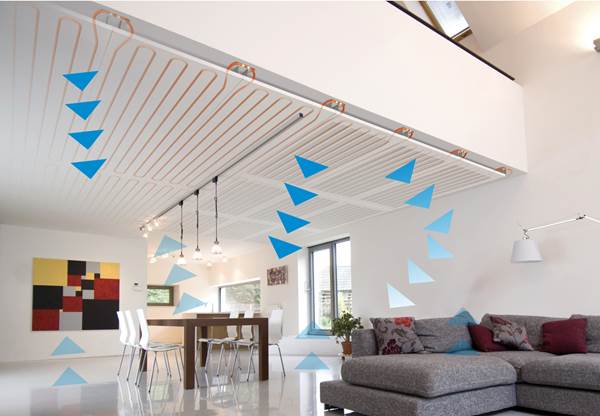
Are you looking for a healthy alternative to an air conditioning system? Ceiling cooling offers a healthy, energy-efficient alternative. It cools silently and can also run at night. And the coolest thing about it is that in winter, the ceiling gives you cosy warmth.
In a world where the requirement for cooling is growing and the need to act on energy usage is urgent a system that saves 30% demands our attention. Add in the health benefits that radiant cooling brings compared to conventional forced air systems plus the enhanced comfort for the building occupants and you have a powerful case for change. A study by Lawrence Berkeley National Laboratory in the US estimated an average saving of 30% on running costs for the entire US. The study also calculated that radiant cooling has lower initial costs and lower lifecycle costs due energy saving and lower maintenance.
How does it work?
All these benefits are possible thanks to the fact that aluminium multi-layer composite pipes are laid over a large area of the ceiling (around 70 to 80 percent), where the water circulates in the summer at a temperature between 16 and 20°C. This allows the ceiling surfaces to provide gentle cooling, while absorbing the heat irradiated by furniture, floors, walls – and of course, the people in the room.
During the winter, however, water is pumped through the aluminium multi-layer composite pipes at a temperature of between 26 and 38°C. A comfortable radiant heat spreads throughout the room, at right-angles to the surface. With ceiling heating, this means from top to bottom. The radiating waves are converted to heat when they hit furnishings and unheated surfaces. Fixed elements in the room absorb the radiation and emit the absorbed energy back into the room as heat.
More freedom for interior design
Air conditioning units are often bulky and take up a lot of space. Ceiling cooling systems are hidden discretely in the room and offer a great deal of freedom when it comes to designing the interiors. Large cupboards, mirrors or wall units can be positioned wherever you want. There are also hardly any limits in terms of lights or other fixtures on the ceiling
What energy source does ceiling cooling need?
Anyone using a Variotherm ceiling for cooling purposes needs cooled water. Ideally, the energy needed is obtained directly from the surrounding environment, using bore hole drilling, surface collectors or a heat pump. The latter takes the energy needed from environmentally friendly sources: air, earth or ground water. The integrated compressor generates the water temperature of between 16 and 20°C needed for cooling.
Lower energy costs with greater comfort
If the ceiling is used for cooling, the rooms already feel comfortable at 26°C thanks to the thermal radiation exchange, and not only when the temperature reaches 23°C as is the case with air conditioning units. The reason why is obvious: the human body emits the temperature evenly onto the surrounding surfaces such as the floor, wall and ceiling. As a result, the perceived temperature is two to three degrees lower than the actual room temperature.
Variety and adaptability when mounting
A ceiling cooling/heating system is installed over a large area in order to guarantee the best possible cooling and heating result and to optimise the run times of the heat pump. Ceiling cooling/heating can be laid both under plaster and at a later dry construction stage.
The cooling ceilings provide cooling of 60 to 80 W/m². The dew point and condensation are insignificant, since the cooling pipes do not come into direct contact with the room air.
Requirements for ceiling cooling
https://www.variotherm.com/en/